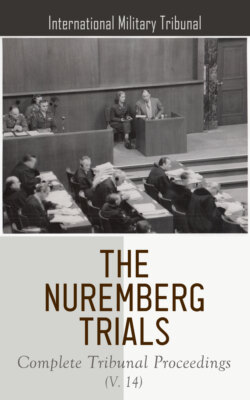Читать книгу The Nuremberg Trials: Complete Tribunal Proceedings (V. 11) - International Military Tribunal - Страница 6
На сайте Литреса книга снята с продажи.
Оглавление“I am the former Director of the shipbuilding yard of Blohm & Voss in Hamburg. I was with this firm from 1937 to 1945”—pardon me—“from 1907 to 1945 and I am conversant with all questions concerning the construction of warships and merchant ships. In particular, as an engineer I had detailed information about the building of battleships for the German Navy. Dr. Walter Siemers, attorney at law of Hamburg, presented to me the Document C-23, dated 18 February 1938, and asked me to comment on it. This document shows that the Navy, contrary to the previous agreement, informed the British that the battleships Scharnhorst and Gneisenau—as well as other intended constructions—had a displacement and draught of about 20 percent less than was actually the case.
“I can give some details to explain why this information was given. I assume that the information given to the British—information which according to naval agreement 4 had to be supplied 4 months before the keel was laid down—was based on the fact that the battleships Scharnhorst and Gneisenau were originally intended to have a displacement of 26,000 tons and a draught of 7.50 meters and the battleship “F” (Bismarck) a displacement of 35,000 tons and a draught of 7.90 meters, as stated.
“If these battleships were afterwards built with a greater displacement and a greater draught, the changes were the result of orders given or requests made by the Navy while the plans were being drafted and which the construction office had to carry out. The changes were based upon the viewpoint repeatedly expressed by the Navy—namely, to build the battleships in such a way that they would be as nearly unsinkable as possible. The increase of the tonnage was not meant to increase the offensive power of the ship”—I beg your pardon, Mr. President. I shall be finished in a moment—“The increase of the tonnage was not meant to increase the offensive power of the ship but was done for defensive and protective purposes.”
I may perhaps point out that in the English text there is a mistake in translation. In this text the word “not” is missing. It should read, “was not meant,” and not “meant.”
“As time went on, the Navy attached more and more importance to dividing the hull of the battleship into a greater number of compartments in order to make the ship as unsinkable as possible and to afford the maximum protection in case of leakage. The new battleships were therefore built broad in the beam with many bulkheads, only about ten meters apart, and many longitudinal and latitudinal bulkheads outside the torpedo bulkhead. At the same time, both the vertical and the horizontal armor-plating were, as far as my information goes, heavier and composed of larger plates than those used by other navies. In order...”
THE PRESIDENT: In other words, his explanation is that they were altered in the course of construction for technical reasons. It does not matter what the technical reasons are.
DR. SIEMERS: I beg your pardon, Mr. President, but I do believe that when we are dealing with a clearly-established violation of a treaty, the manner of this violation is of some importance. I do not believe that each and every violation of a treaty can be described as a war crime. The point is whether this violation of the treaty was a war crime in the sense of the Charter—in other words, whether it was motivated by the intention of waging a war of aggression. An insignificant violation of a kind which, after all, is found in every commercial lawsuit cannot be a crime.
THE PRESIDENT: The affidavit is before us. We shall read it. In fact, you have already read the material parts of it.
Now, I think we had better adjourn. How long do you expect to be?
DR. SIEMERS: Mr. President, it is very difficult for me to judge that accurately, but I imagine I shall be able to conclude sometime tomorrow. I hope, Mr. President, that I shall be able to conclude at noon; but I am asking Your Honor to take into consideration the fact that I am incorporating my documentary proof in the interrogation and that this documentary proof, which in many other cases has taken hours to present, is thus dealt with simultaneously.
THE PRESIDENT: The Tribunal hope that you will make your presentation as short as you possibly can. We have already been so long a time over this defendant.
[The Tribunal recessed until 1400 hours.]
